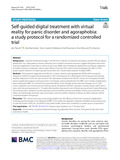Citation link:
http://dx.doi.org/10.25819/ubsi/10247Files in This Item:
| File | Description | Size | Format | |
|---|---|---|---|---|
| Self-guided_digital_treatment_with_virtual_reality_panic_disorder_agoraphobia.pdf | 839.1 kB | Adobe PDF |  View/Open |
| Dokument Type: | Article | metadata.dc.title: | Self-guided digital treatment with virtual reality for panic disorder and agoraphobia | Title addition: | a study protocol for a randomized controlled trial | Authors: | Planert, Jari Machulska, Alla Hildebrand, Anne‑Sophie Roesmann (Keuper), Kati Otto, Esra Klucken, Tim |
Institute: | Fakultät V - Lebenswissenschaftliche Fakultät | Free keywords: | Virtual reality, Cognitive behavioral therapy, Agoraphobia, Panic disorder, Self-guided help, Short-term treatment, E-health | Dewey Decimal Classification: | 150 Psychologie | GHBS-Clases: | HQN HSG HVQH HVRG |
Issue Date: | 2022 | Publish Date: | 2023 | Source: | Trials ; 23, article number 426. - https://doi.org/10.1186/s13063-022-06366-x | Abstract: | Background Cognitive behavioral therapy is the first-line treatment for patients with panic disorder (PD) and agoraphobia (AG). Yet, many patients remain untreated due to limited treatment resources. Digital self-guided short-term treatment applications may help to overcome this issue. While some therapeutic applications are already supported by health insurance companies, data on their efficacy is limited. The current study investigates the effect of self-guided digital treatment comprising psychoeducation and virtual reality exposure therapy (VRET). Methods Thirty patients diagnosed with PD, AG, or panic disorder with agoraphobia (PDA) will be randomly assigned to either the experimental group (EG) or the control group (CG). Participants of both groups will undergo baseline diagnostics in the first two sessions. The subsequent treatment for the EG consists of a self-guided 6-week phase of application-based psychoeducation, one therapy session preparing for the VRET, and 4 weeks of application-based self-guided VRET. To control for the potential effects of the therapy session with the therapist, the CG will receive relaxation and stress-reduction training instead. All patients will then undergo a closing session which terminates with the post-assessment (~ 10 weeks after baseline assessment) and a follow-up assessment 6 weeks following the closing session. Symptom severity (primary outcome) will be assessed at baseline, interim, post-treatment, and follow-up. Additionally, remission status (secondary outcome) will be obtained at follow-up. Both measures will be compared between the groups. Discussion The current study aims at providing insights into the efficacy of short-term treatment applications including psychoeducation and self-guided VRET. If successful, this approach might be a feasible and promising way to ease the burden of PD, AG, and PDA on the public health system and contribute to a faster access to treatment. |
Description: | Finanziert im Rahmen der DEAL-Verträge durch die Universitätsbibliothek Siegen |
DOI: | http://dx.doi.org/10.25819/ubsi/10247 | URN: | urn:nbn:de:hbz:467-24416 | URI: | https://dspace.ub.uni-siegen.de/handle/ubsi/2441 | License: | http://creativecommons.org/licenses/by/4.0/ |
| Appears in Collections: | Geförderte Open-Access-Publikationen |
This item is protected by original copyright |
Page view(s)
434
checked on Nov 30, 2024
Download(s)
190
checked on Nov 30, 2024
Google ScholarTM
Check
Altmetric
This item is licensed under a Creative Commons License


